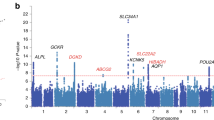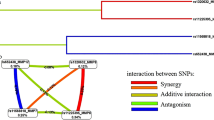Abstract
Tissue kallikrein is an enzyme involved in the release of kinin in peripheral tissues. It is believed to regulate hemodynamics and electrolyte transport in the kidney. The present study analyzed polymorphisms of tissue kallikrein in Japanese volunteers and examined the associations between allele H in the promoter region, which has been shown to have decreased promoter activity, and urinary kallikrein activity and physiological parameters in subjects on an ad libitum diet. Ninety and 73 volunteers were analyzed for the promoter and coding regions of the tissue kallikrein gene, respectively. The allelic frequency of allele H was found to be 24%. One synonymous and three non-synonymous polymorphisms were found in the coding regions. Urinary kallikrein activity was not significantly decreased in subjects with allele H compared to those without allele H, although they were low in two homozygotes of allele H. Urinary excretions of calcium and sodium were larger in the subjects with allele H than in those without. It is concluded that allele H is a common polymorphism in Japanese and may contribute to decreased reabsorptions of calcium and sodium in the kidney. Further interventional studies are needed to clarify the phenotype of allele H with respect to renal electrolyte handling.
Similar content being viewed by others
Introduction
Human tissue kallikrein is a family of 15 genes (hKLK1–hKLK15) located on chromosome 19q13.3–13.4. The product of hKLK1 is a kinin-forming serine protease and the enzyme is synthesized in many organs including the kidney. The renal kallikrein–kinin system is involved in salt-sensitive hypertension.1, 2
hKLK1 shows polymorphisms in the coding and promoter regions. A loss-of-function coding polymorphism (G230A) was found in Caucasians and Africans.3 An allele H polymorphism, whose promoter activity was decreased by 85% of the control, was found in Asians at an allelic frequency of 25%.4 This allelic frequency was higher in hypertensive Chinese patients than in their normotensive counterparts.5
hKLK1 is abundantly synthesized in the renal distal tubules and is secreted in urine. The above loss-of-function polymorphism was demonstrated to associate with reduced urinary hKLK1 activity in hypertensive patients.3
We analyzed hKLK1 polymorphisms in healthy Japanese volunteers and examined urinary hKLK1 activity and physiological phenotypes in these subjects with and without allele H.
Materials and methods
The Ethics Committee of Kitasato University School of Medicine and Kitasato University Hospital approved this study. Healthy Japanese volunteers (age range, 20–45 years, male/female 27/46) participated in the study after informed consent was obtained.
hKLK1 polymorphisms were identified by a sequencing of genomic DNA including the promoter, five exons, and 10–50 bp of intronic sequences per exon (Applied Biosystems, Foster City, CA, USA). The reference gene sequence was obtained from GenBank (AY094609). Ninety Japanese volunteers were examined for the polymorphic promoter region, −133 to −121 from the transcription initiation site, and 73 were examined for the coding region.
Physiological characteristics were measured in the morning under an uncontrolled diet. Blood samples were collected in a supine position. Urine samples were collected spontaneously (first collection) and by urination after intake of 500 ml of water (second collection). Urinary hKLK1 activity was measured using a fluorogenic substrate.6 Laboratory tests were measured by SRL Inc. (Tokyo, Japan).
Gender distributions between the subjects with and without allele H were analyzed by a χ2-test for independence. The physiological characteristics were compared using an unpaired t-test.
Results
Table 1 presents the allelic frequencies of the hKLK1 polymorphisms as reported in previous studies.3, 4, 7 Alleles A, B, H and K were also identified in Japanese. The frequency of allele H was 24%, which was similar to Asians.
Three subjects carried allele H homozygously. Three non-synonymous polymorphisms, C433G in exon 3 and C514T and A556G in exon 4, were identified. The subjects who had C433G also carried a synonymous polymorphism, C405T. The absence of disequilibrium was indicated between H and C405T/C433G (χ2-test, P=0.026) and between K and C405T/C433G (χ2-test, P<0.0001) polymorphisms (data not shown).
Table 2 shows a comparison of urinary hKLK1 activity and physiological parameters between the subjects with and without allele H. Although urinary hKLK1 activity was not significantly different, two subjects who were homozygous for allele H displayed low urinary hKLK1 activity (Figure 1a). The fractional excretion of calcium in urine and urinary calcium excretion were larger in the allele-H subjects than in the non-allele-H subjects. Urinary sodium excretion was larger in the second collection in the allele-H subjects.
Comparison of urinary hKLK1 activity and urinary excretions of sodium, potassium and calcium between subjects with and without allele H. Graphs show individual urine data from the second collection, which was newly produced urine after water intake. Urinary hKLK1 activity (a) and urinary excretions of sodium (b), potassium (c) and calcium (d) were compared between the subjects with and without allele H. Each symbol indicates the heterozygotes of allele H (gray square) and homozygotes of allele H (black triangle, n=2: male 1, female 1) and subjects without allele H (black diamond). Data were expressed as amounts per milligram urinary creatinine. Bars indicate the mean. The total number of subjects was 73 for a, b and c, and 60 for d. *P<0.05; NS, not significant.
Discussion
The allele-H polymorphism of hKLK1 promoter was found in Japanese as common as in Asians.4 A loss-of-function polymorphism of G230A located on exon 3 was not identified. Other non-synonymous polymorphisms, C433G and A556G, were common, but the former is not responsible for decreased hKLK1 activity.3 The activity of hKLK1 is determined by three specific amino-acid residues for substrate binding and the nucleotide sequences are located on exons 2, 3 and 5. A556G is located on exon 4 and urinary hKLK1 activity was not different between the subjects with and without A556G (data not shown).
Possible reasons for the slight but insignificant lower urinary hKLK1 activity in subjects with allele H than in those without allele H are as follows; the other allele might compensate for the lower activity, spot urine might not reflect the total biogenesis of hKLK1,8 and potassium intake, a known secretagogue of hKLK1, was not controlled.6, 9 A higher urinary calcium excretion in subjects with allele H than in those without allele H may be explained by reduced renal tubular calcium reabsorption.10, 11, 12 A difference in urinary sodium excretion in the second collection may reflect reduced activity of renal tubular epithelial sodium channels.13 Such ionic transports are known to be controlled by hKLK1 in the renal distal tubules and may not be kinin-mediated.14
Further studies will be needed to identify the roles of a common polymorphism of allele H in the regulation of urinary excretions of calcium and sodium under a controlled diet. The present results can be applied to a pharmacogenetic study to examine an inter-individual difference in the response to diuretics acting on the renal distal tubule.
References
Katori, M. & Majima, M. The renal kallikrein-kinin system: its role as a safety valve for excess sodium intake, and its attenuation as a possible etiologic factor in salt-sensitive hypertension. Crit. Rev. Clin. Lab. Sci. 40, 43–115 (2003).
Katori, M. & Majima, M. A missing link between a high salt intake and blood pressure increase. J. Pharmacol. Sci. 100, 370–390 (2006).
Slim, R., Torremocha, F., Moreau, T., Pizard, A., Hunt, S. C., Vuagnat, A. et al. Loss-of-function polymorphism of the human kallikrein gene with reduced urinary kallikrein activity. J. Am. Soc. Nephrol. 13, 968–976 (2002).
Song, Q., Chao, J. & Chao, L. DNA polymorphisms in the 5'-flanking region of the human tissue kallikrein gene. Hum. Genet. 99, 727–734 (1997).
Hua, H., Zhou, S., Liu, Y., Wang, Z., Wan, C., Li, H. et al. Relationship between the regulatory region polymorphism of human tissue kallikrein gene and essential hypertension. J. Hum. Hypertens. 19, 715–721 (2005).
Fujita, T., Ogino, M., Daigo, F., Yamaguchi, T. & Majima, M. Intracellular Ca2+ contributes to K+-induced increase in renal kallikrein secretion. Int. Immunopharmacol 6, 1487–1495 (2006).
Zhao, W., Wang, L., Lu, X., Yang, W., Huang, J., Chen, S. et al. A coding polymorphism of the kallikrein 1 gene is associated with essential hypertension: a tagging SNP-based association study in a Chinese Han population. J. Hypertens. 25, 1821–1827 (2007).
Tsai, T. J., Chen, Y. M., Hsieh, B. S. & Chen, W. Y. Comparison between spot urine and overnight urine in the estimation of 24-hour excretion of urine protein, sodium and kallikrein. J. Formos. Med. Assoc. 90, 755–759 (1991).
Suzuki, T., Katori, M., Fujita, T., Kumagai, Y. & Majima, M. Involvement of the renal kallikrein-kinin system in K(+)-induced diuresis and natriuresis in anesthetized rats. Eur. J. Pharmacol 399, 223–227 (2000).
Picard, N., Van Abel, M., Campone, C., Seiler, M., Bloch-Faure, M., Hoenderop, J. G. et al. Tissue kallikrein-deficient mice display a defect in renal tubular calcium absorption. J. Am. Soc. Nephrol. 16, 3602–3610 (2005).
Gkika, D., Topala, C. N., Chang, Q., Picard, N., Thébault, S., Houillier, P. et al (2006) Tissue kallikrein stimulates Ca(2+) reabsorption via PKC-dependent plasma membrane accumulation of TRPV5. EMBO. J 25, 4707–4716 (2006).
Blanchard, A., Azizi, M., Peyrard, S., Stern, N., Alhenc-Gelas, F., Houillier, P. et al. Partial human genetic deficiency in tissue kallikrein activity and renal calcium handling. Clin. J. Am. Soc. Nephrol. 2, 320–325 (2007).
Picard, N., Eladari, D., El Moghrabi, S., Planès, C., Bourgeois, S., Houillier, P. et al. Defective ENaC processing and function in tissue kallikrein-deficient mice. J. Biol. Chem 283, 4602–4611 (2008).
Pizard, A., Richer, C., Bouby, N., Picard, N., Meneton, P., Azizi, M. et al. Genetic deficiency in tissue kallikrein activity in mouse and man: effect on arteries, heart and kidney. Biol. Chem 389, 701–706 (2008).
Acknowledgements
This study was supported by the 35th research grant from the Japan Research Foundation for Clinical Pharmacology. We would like to acknowledge the medical staff of the Clinical Trial Center of Kitasato University East Hospital for their assistance with conducting the human study, and Stephen McKay, MSc, of McKay MedPharm & Associates for his assistance with editing the manuscript.
Author information
Authors and Affiliations
Corresponding author
Ethics declarations
Competing interests
All authors declare no conflict of interest.
Rights and permissions
About this article
Cite this article
Fujita, T., Yasuda, S., Kamata, M. et al. A common polymorphism in the tissue kallikrein gene is associated with increased urinary excretions of calcium and sodium in Japanese volunteers. J Hum Genet 58, 758–761 (2013). https://doi.org/10.1038/jhg.2013.93
Received:
Revised:
Accepted:
Published:
Issue Date:
DOI: https://doi.org/10.1038/jhg.2013.93




